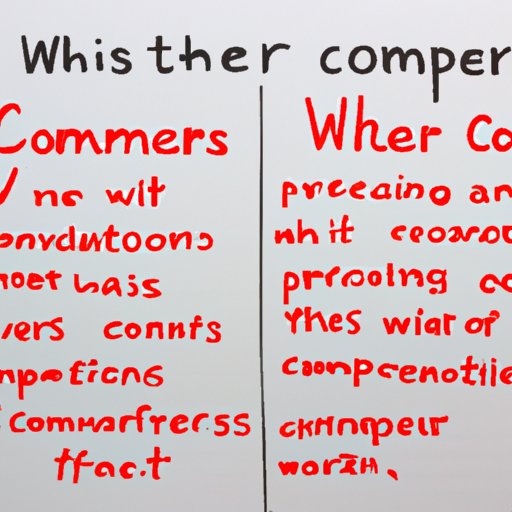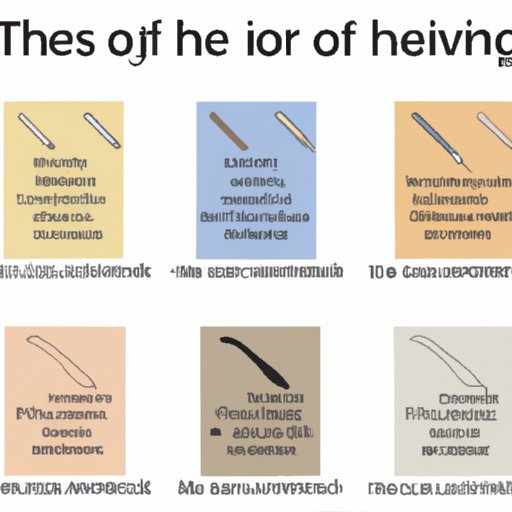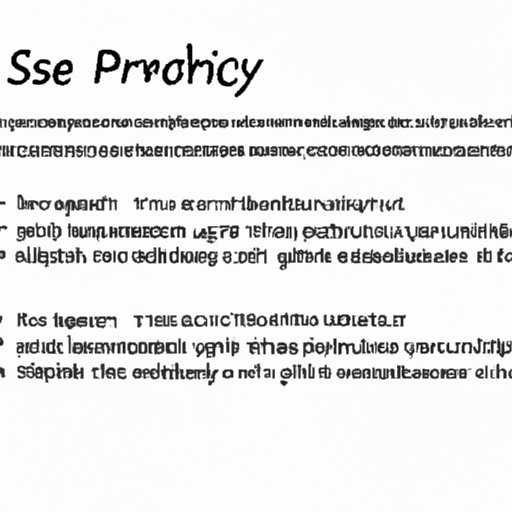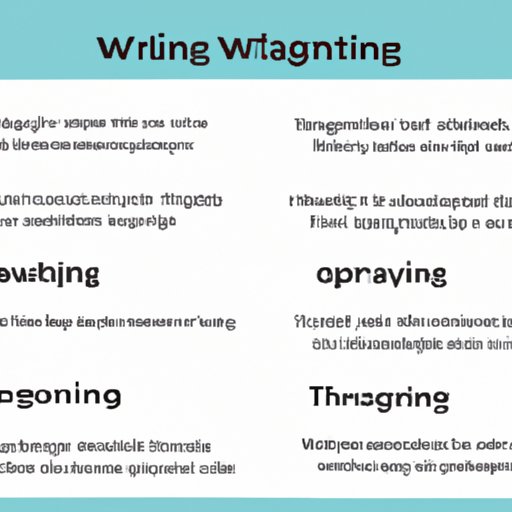Introduction
Writing is a form of communication that has been used throughout history to express ideas, share stories, and convey information. There are many different types of writing that serve distinct purposes, and understanding them can be a great way to improve your writing skills. In this article, we’ll take a look at the seven types of writing and how they can be used in various contexts.
Listicle: 7 Types of Writing Explained
The seven types of writing are narrative, expository, descriptive, persuasive, argumentative, creative, and technical. Each of these types of writing has its own unique characteristics and purpose. Let’s explore each one in more detail.
1. Narrative Writing
Narrative writing is used to tell stories. It typically follows the structure of a plot, which includes a beginning, middle, and end. The goal of narrative writing is to transport readers into a different world and make them feel as if they are part of the story. Character development and dialogue are also important components of narrative writing.
Examples of narrative writing include novels, short stories, plays, and screenplays.
2. Expository Writing
Expository writing is used to explain or inform. It is typically written in a clear, straightforward style, and it often uses facts and evidence to support its arguments. The goal of expository writing is to provide readers with information they may not have known before.
Examples of expository writing include news articles, research papers, and instructional manuals.
3. Descriptive Writing
Descriptive writing is used to create vivid images in the reader’s mind. It relies heavily on sensory details and figurative language such as similes and metaphors. The goal of descriptive writing is to evoke an emotional response from the reader.
Examples of descriptive writing include poetry, song lyrics, and travel writing.
4. Persuasive Writing
Persuasive writing is used to convince readers to take a certain action or adopt a specific viewpoint. It often includes evidence and statistics to support its claims, as well as emotional appeals. The goal of persuasive writing is to persuade readers to agree with the author’s point of view.
Examples of persuasive writing include advertisements, speeches, and op-eds.
5. Argumentative Writing
Argumentative writing is similar to persuasive writing, but it takes a stronger stance on an issue. It presents both sides of an argument, but it ultimately seeks to prove that one side is more valid than the other. The goal of argumentative writing is to prove a point through logic and evidence.
Examples of argumentative writing include essays, debates, and court briefs.
6. Creative Writing
Creative writing is used to express one’s imagination and emotions. It often takes the form of fiction, but it can also be used to express personal experiences. The goal of creative writing is to capture the reader’s attention and evoke an emotional response.
Examples of creative writing include novels, short stories, and memoirs.
7. Technical Writing
Technical writing is used to communicate complex topics to a specific audience. It often includes detailed instructions and step-by-step procedures. The goal of technical writing is to provide readers with clear and concise information.
Examples of technical writing include user manuals, computer programming guides, and medical textbooks.

Comparison: Comparing and Contrasting the Different Types of Writing
Now that we’ve explored the seven types of writing, let’s compare and contrast them to get a better understanding of how they differ. Here are some key distinctions between some of the major types of writing.
Narrative vs. Expository Writing
Narrative writing is used to tell stories, while expository writing is used to explain or inform. Narrative writing focuses on character development and dialogue, while expository writing relies on facts and evidence. Narrative writing is meant to evoke an emotional response, while expository writing is meant to provide readers with information.
Descriptive vs. Persuasive Writing
Descriptive writing is used to create vivid images in the reader’s mind, while persuasive writing is used to convince readers to take a certain action. Descriptive writing relies heavily on sensory details and figurative language, while persuasive writing relies on evidence and emotional appeals. Descriptive writing is meant to evoke an emotional response, while persuasive writing is meant to persuade readers to agree with the author’s point of view.
Argumentative vs. Creative Writing
Argumentative writing is similar to persuasive writing, but it takes a stronger stance on an issue. Creative writing is used to express one’s imagination and emotions. Argumentative writing presents both sides of an argument and seeks to prove one side is more valid, while creative writing is meant to capture the reader’s attention and evoke an emotional response.
Technical Writing Compared to All Other Types
Technical writing is unique in that it is used to communicate complex topics to a specific audience. It often includes detailed instructions and step-by-step procedures. Technical writing is meant to provide readers with clear and concise information, while all other types of writing are meant to evoke an emotional response or persuade readers to take a certain action.
Breakdown: Breaking Down the Different Types of Writing
Now that we’ve compared and contrasted the different types of writing, let’s take a closer look at each one. Here are some key characteristics and examples of the seven types of writing.
1. Narrative Writing
Characteristics: Follows the structure of a plot; focuses on character development and dialogue; evokes an emotional response.
Examples: Novels, short stories, plays, and screenplays.
2. Expository Writing
Characteristics: Clear, straightforward style; uses facts and evidence to support its arguments; provides readers with information.
Examples: News articles, research papers, and instructional manuals.
3. Descriptive Writing
Characteristics: Creates vivid images in the reader’s mind; relies heavily on sensory details and figurative language; evokes an emotional response.
Examples: Poetry, song lyrics, and travel writing.
4. Persuasive Writing
Characteristics: Includes evidence and statistics to support its claims; uses emotional appeals; persuades readers to agree with the author’s point of view.
Examples: Advertisements, speeches, and op-eds.
5. Argumentative Writing
Characteristics: Presents both sides of an argument; seeks to prove that one side is more valid than the other; uses logic and evidence.
Examples: Essays, debates, and court briefs.
6. Creative Writing
Characteristics: Expresses one’s imagination and emotions; captures the reader’s attention; evokes an emotional response.
Examples: Novels, short stories, and memoirs.
7. Technical Writing
Characteristics: Communicates complex topics to a specific audience; includes detailed instructions and step-by-step procedures; provides readers with clear and concise information.
Examples: User manuals, computer programming guides, and medical textbooks.
How-To Guide: How to Choose the Right Type of Writing for Your Project
Once you’ve familiarized yourself with the different types of writing, you’ll need to decide which one is best suited for your project. Here are some tips for choosing the right type of writing for your project.
1. Identify Your Purpose
Before you start writing, it’s important to identify your purpose. Are you trying to tell a story, explain a concept, or persuade someone to take a certain action? Knowing your purpose will help you decide which type of writing is most appropriate for your project.
2. Consider Your Audience
It’s also important to consider your audience when deciding which type of writing to use. Who are you writing for? Are you writing for experts in a particular field, or for a general audience? Understanding your audience will help you decide which type of writing is most effective for communicating your message.
3. Know Your Genre
Different genres have their own conventions and expectations, so it’s important to know which genre you’re writing in. For example, if you’re writing a novel, you’ll want to focus on character development and dialogue. If you’re writing a research paper, you’ll want to focus on facts and evidence. Knowing your genre will help you choose the right type of writing for your project.
4. Balance Creativity and Clarity
Finally, it’s important to balance creativity and clarity in your writing. Creative writing often relies on figurative language and emotional appeals, while technical writing relies on facts and clear instructions. Make sure your writing strikes the right balance between creativity and clarity.

History: Tracing the Evolution of the 7 Types of Writing
Writing has been around since ancient times, and over the centuries it has evolved and changed to meet the needs of different societies. Let’s take a look at the history of writing and how it has developed into the seven types of writing we know today.
Ancient Roots of Writing
The earliest forms of written communication date back to ancient Mesopotamia and Egypt, where scribes used pictograms and cuneiform to record information. Over time, these primitive forms of writing evolved into the alphabets we use today.
Development of Different Types of Writing Through the Ages
As civilizations grew and technology advanced, so did the written word. Narrative writing became popular in ancient Greece and Rome, while expository writing flourished during the Renaissance. With the invention of the printing press, books and newspapers became widely available, leading to the emergence of persuasive and argumentative writing. Creative writing began to take shape in the 19th century, and technical writing emerged as a distinct field in the 20th century.

Case Study: Examining a Specific Example of Each Type of Writing
Now that we’ve traced the evolution of the seven types of writing, let’s examine a specific example of each one.
1. Narrative Writing
One of the most iconic examples of narrative writing is William Shakespeare’s play Hamlet. The play follows the titular character as he struggles with his inner demons and navigates the treacherous political landscape of Denmark.
2. Expository Writing
A great example of expository writing is Charles Darwin’s On the Origin of Species. The book explains Darwin’s theory of evolution and provides evidence to support his claims.
3. Descriptive Writing
An excellent example of descriptive writing is John Keats’ poem “Ode to a Nightingale.” The poem paints a vivid picture of a nightingale singing in a forest, and it uses powerful imagery to evoke an emotional response in the reader.
4. Persuasive Writing
Martin Luther King Jr.’s “I Have a Dream” speech is a perfect example of persuasive writing. The speech uses powerful rhetoric and emotional appeals to persuade listeners to fight for racial equality.
5. Argumentative Writing
John Stuart Mill’s essay “On Liberty” is a classic example of argumentative writing. The essay presents two sides of the argument and ultimately seeks to prove that individual liberty is essential to a healthy society.
6. Creative Writing
F. Scott Fitzgerald’s novel The Great Gatsby is an exemplary example of creative writing. The novel tells the story of Jay Gatsby, a wealthy socialite who is desperate to win back the love of his life. The novel is full of symbolism and metaphors, and it captures the reader’s attention from start to finish.
7. Technical Writing
The Microsoft Word manual is a great example of technical writing. The manual provides detailed instructions on how to use the software, and it is written in a clear and concise manner.
Conclusion
In conclusion, there are seven types of writing: narrative, expository, descriptive, persuasive, argumentative, creative, and technical. Each type of writing has its own unique characteristics and purpose, and understanding them can help you choose the right type for your project. Knowing the history of writing can also give you insight into how the different types have evolved over time. Finally, examining specific examples of each type of writing can help you gain a better understanding of how they are used.
Understanding the seven types of writing can be a great way to improve your writing skills. It can also help you determine which type of writing is best suited for your project, and which techniques you can use to make your writing more effective.
(Note: Is this article not meeting your expectations? Do you have knowledge or insights to share? Unlock new opportunities and expand your reach by joining our authors team. Click Registration to join us and share your expertise with our readers.)
